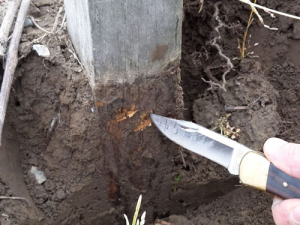With current estimates of 36,000 hectares of vineyard in New Zealand, the vines are supported by around 21 million posts. The majority of those are CCA treated radiata pine. In recent years, concerns have been raised over the potential of CCA leaching into the soil, and the impact this could have on New Zealand’s sustainable image.
Up to five percent of all posts (around a million a year) are thought to be broken or damaged due to machinery, and removed from the vineyard. However with limited ability to recycle them or dispose in landfills, due to the CCA treatment, the broken posts are ending up stored in corners of vineyards.
When concerns began being raised about the possible ramifications of CCA treated pine, a number of individuals began looking at alternatives. One of those was to utilise natural hardwood, such as certain Eucalypt species, which require no chemical treatment to endure below ground conditions.
In 2003 Vineyard Timbers Ltd, based in Marlborough, began trialing a range of Eucalypt species and identified several promising ones, including the coast grey box (E. bosistoana) and white stringybark (E. globoidea). These two species are the first to have been selected for genetic improvement; others will follow. The former is expected to last in the ground for 20 to 25 years, while the latter lifespan is expected to be 15-20 years.
Between 2006 and 2009 six vineyards in Marlborough’s Lower Wairau Valley were supplied with 1400 durable hardwood posts milled from trees already growing in New Zealand. Now more than a decade on, the initial vineyards have been surveyed to determine what form of decay the posts have suffered and to gauge the owner’s experience of working with them.
Four of the vineyards had installed the posts as replacements for broken CCA-treated posts; one used them in setting up a new vineyard and another in a small feijoa orchard. Five of the properties are organic, with mechanical harvesting and some mechanical pruning. Two also use mechanical under-vine cultivation.
The results of the survey showed that 1065 of the original 1400 initially sold are still in use. Another 14 were found broken, one failed from decay and 45 were in storage.
The feedback from vineyard owners was positive. The natural durability has fitted in well with those under organic management, while the strength leading to a lack of breakage was highlighted. With only 14 of the 1065 original posts broken by machinery, it was discovered that the majority had broken at the point of a knot in the wood, something that could be eliminated with stricter quality control. Overall the annual breakage rate is far lower than the five percent annual breakage rate of radiata pine posts.
But perhaps the best news of all for those involved, is that only one of the posts had severe decay, despite none of them having been chemically treated for ground use. The in-ground assessments of 150 posts showed that the coast grey box posts were all still is use, with very low levels of decay, “as would be expected due to their class one durability classification in the Australian Standard.”
By comparison the white stringybarkposts are showing somewhat higher decay rate, (particularly on one site) although a large number are still in service and can be expected to continue so for a number of years.
There were a few negatives to emerge, mainly that the hardness of the wood meant it was difficult to nail clips and wire hangers into, although it was mentioned that this could have been alleviated by pre-drilling.
While this research/survey has provided valuable information, there will be further analysis undertaken in another five years’ time.










